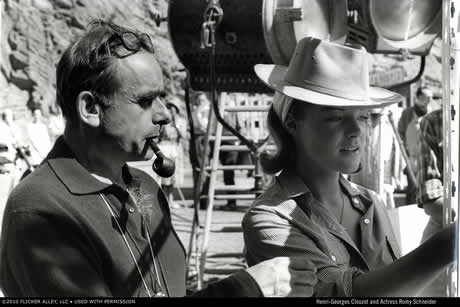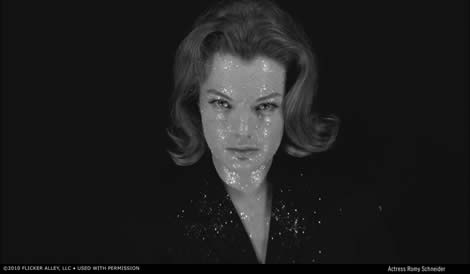 Directors Serge Bromberg (a famed film restorer) and Ruxandra Medrea have resurrected Henri-Georges Clouzot’s ill-fated, legendary “Inferno“.
Directors Serge Bromberg (a famed film restorer) and Ruxandra Medrea have resurrected Henri-Georges Clouzot’s ill-fated, legendary “Inferno“.
After a chance meeting in a stalled elevator, Clouzot’s widow, Inès Clouzot, gave access to all the surviving footage (15 hours). Out of this stunning, experimental, op art and early psychedelic footage, Bromberg has crafted both a demi-reconstruction and a tale of what went wrong with the production. Interviews with cast and crew, including Catherine Allégret, future director (then 1st AD) Costa-Gavras and future cinematographer (then camera assistant) William Lubtchansky detail a fascinating story of artistic hubris.
Like “Lost In La Mancha“, Fulton and Pepe’s study of “Quixote”, the Gilliam film that died after extensive pre-production, Bromberg and Medrea’s film is haunted by the wonders of an unfinished project by a visionary filmmaker.
Clouzot lived for ten years at the hub of France’s cultural scene, Paul Roux’s famed inn, the Columbe D’or, in Saint Paul de Vence. Inn-mates included Sergio Reggiani, Yves Montand, Simone Signoret and her daughter (with director Yves Allégret), Catherine Allégre. Clouzot offered a part to the novice actress Allégret.
Veteran director Clouzot had produced classic thrillers like “Le Corbeau”, “The Wages of Fear”, and “Diabolique”. Based on his bold visual experiments into subjective pov, Columbia Pictures gave Clouzot Carte blanche and an unlimited budget. Exacting Clouzot was sandbagged by the budget.
Clouzot’s choice of location- the remote Hotel Garabit in the Cantal, with its lake and a train viaduct, left the production only 4 weeks of exterior shots before the artificial lake would be drained for a power generator (an impossible task because of Clouzot’s endless reshoots.)
Clouzot, an insomniac, would summon cast and crew at any time of day or night, driving himself and his cast to the point of breakdown, obsessively reshooting sequences. Clouzot liked to drive his actors till they cracked, shooting the vulnerability that followed catharsis. Crew and cast members, who had looked forward to working on a “historic” film, lost faith. Clouzot drove Reggiani so hard; he quit the project, leaving a half-finished film without a star. Clouzot’s attempt to recast Jean-Louis Trintignant failed and the director suffered a  heart attack.
heart attack.
Inspired by Fellini’s stylistically groundbreaking “8 1/2“, and by the innovations of the Nouvelle Vague directors, Clouzot developed a battery of cinematic techniques to illustrate the inner monologue of a husband driven crazy by jealousy. Seeking a new “plastic representation,” Clouzot commissioned famed kinetic artist Jean-Pierre Yvarel (Vasarely) to reconstruct certain of his kinetic sculptures in the film studio. Ultimately Yvarel (and effects artist Joel Stein) created radical special effects. Pre-production became an experimental lab for the artists, as Clouzot sought a way to integrate his actors into the challenging kinetic images.
Bromberg illustrates the 60’s fascination with Kinetic sculpture and Op art with shots of a Courrèges fashion shoot.
Clouzot commissioned electro-pop star Glbert Any to develop a sound design of distorted and overlapping voices that would suck the audience into Marcel’s descent into madness. Clouzot’s sound design, using distortion and a mix of acoustic and electronic music remained radical for decades.
Clouzot had a dream cast. Serge Reggiani played Marcel and 26-year old Romy Schneider, at the height of her beauty, plays the cheating wife Odette. Scenes with leads Reggiani and Schneider make one long to see the completed film.
To work with, Bromberg had completed scenes (minus soundtracks) and meticulous tests ranging from costume and lenses to kinetic-art optical effects. Bromberg assembled the film, using actors Bérénice Bejo and Jacques Gamblin to over dub and stage-read the missing scenes.
There are sensual fragments. A sequence with Schneider water ski-ing is tantalizing, as are group scenes on the hotel terrace. Two women (Schneider and Dany Carrel) make out on a boat (Clouzot was working on this scenes when he had the heart attack.) Even with greened skin and blue lips (as part of a color inversion technique to turn the lake blood-red) Schneider is a haunting femme fatale.
The experimental reels are the glory of the film, substantiating Clouzot’s vision. Seeking a cinematic expressionism, Clouzot proposed realistic scenes in black and white and fantasy sequences of dramatic color reversals. Anticipating their use in film, Clouzot assembled a battery of techniques that were familiar to gallery and Museumgoers of the day. Before Bergman’s “Persona“, Clouzot doubled and morphed faces together, as if to illustrate their psychological enmeshment. Revolving lights bathe close-ups of Schneider’s face, the shadows on her features. As the lights alternate, swinging shadows distort her features, portraying the psychological depths of paranoid jealousy in a way we have never seen before. Blinking eyes, infertile and intense, swirl in a kaleidoscopic effect. Oiled and cellophaned, Schneider seduces the camera. William Lubtchansky describes the constant experiments. “I became a specialist on optical coitus.”
Near the end of the film, Bromberg crafts a sequence with Clouzot as his protagonist. To illustrate the dilemma of a director who’s lost his bearings Bromberg superimposes Clouzot on a crowd scene, wandering, searching like one of Marcel’s fantasies. It’s a coup de cinéma.

